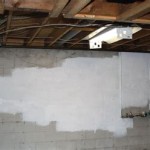What Is A Good Humidity Level For Basement In Winter?
Maintaining appropriate humidity levels in a basement, especially during the winter months, is crucial for preventing a range of issues, including mold growth, structural damage, and health problems. Understanding the ideal humidity range and the factors that influence it can help homeowners create a healthier and more comfortable living environment while protecting their property from potential harm.
Basements are particularly susceptible to high humidity due to their location below ground level. The surrounding soil retains moisture, which can seep into the basement through the concrete foundation. Additionally, basements often have poor ventilation, exacerbating the problem by trapping moisture. During winter, the cold outdoor air can further cool basement surfaces, leading to condensation when warm, moist air comes into contact with them. This creates a favorable environment for mold and mildew to thrive.
The ideal humidity level in a basement during winter typically falls within a specific range. Deviations from this range can lead to various problems, necessitating active management of humidity levels through various methods. Controlling humidity involves a combination of identifying the source of moisture, implementing preventive measures, and utilizing dehumidification equipment as needed. It's essential to monitor humidity levels regularly using a hygrometer to ensure they remain within acceptable parameters.
Understanding Relative Humidity
Relative humidity (RH) is the percentage of water vapor present in the air compared to the maximum amount of water vapor the air can hold at a specific temperature. Warm air can hold more moisture than cold air. Therefore, even if the actual amount of moisture in the air remains the same, the relative humidity will increase as the temperature decreases. This is a key consideration when assessing basement humidity in winter, as the cooling of the basement can lead to higher RH readings even if the moisture source hasn't changed.
The recommended RH level for a basement, particularly during the winter months, is generally between 30% and 50%. Maintaining humidity within this range helps to prevent the growth of mold and mildew, which thrive in environments with high humidity levels. It also helps to protect building materials from moisture damage, such as wood rot and corrosion. Lower humidity levels are also undesirable, as excessively dry air can lead to shrinkage and cracking of wooden structures, as well as discomfort for occupants.
Fluctuations in relative humidity occur naturally throughout the day and with changes in weather conditions. However, persistent high humidity levels are a cause for concern and warrant investigation. Factors contributing to high humidity in basements include groundwater seepage, leaky pipes, inadequate ventilation, and condensation from appliances like washing machines and dryers. Addressing these sources of moisture is crucial for long-term humidity control.
Monitoring relative humidity is best accomplished using a hygrometer, also known as a humidity meter. These devices are relatively inexpensive and readily available at hardware stores and online retailers. Digital hygrometers provide accurate readings and often display both temperature and humidity levels. Place the hygrometer in a central location within the basement, away from direct sunlight and sources of heat or moisture, for an accurate assessment of the average humidity level.
Consequences of High and Low Humidity
When humidity levels in a basement consistently exceed 60%, the risk of mold and mildew growth significantly increases. Mold spores are ubiquitous in the environment, but they require moisture to germinate and grow. Basements provide an ideal environment for mold growth due to their cool, damp conditions and often limited ventilation. Mold can cause a variety of health problems, including allergic reactions, respiratory issues, and skin irritation. In addition, mold can damage building materials, leading to costly repairs.
High humidity can also lead to condensation, which occurs when warm, moist air comes into contact with cold surfaces. Condensation can form on walls, floors, pipes, and other surfaces, providing a constant source of moisture for mold growth and causing materials to deteriorate. Metal objects can rust, wood can rot, and insulation can become less effective when exposed to excessive moisture. Over time, structural damage can occur, compromising the integrity of the building.
Conversely, excessively low humidity levels (below 30%) can also create problems. While mold growth is less likely in dry environments, very dry air can cause wood to shrink and crack. This can be particularly problematic for wooden furniture, flooring, and structural elements. Dry air can also irritate the skin and respiratory system, leading to discomfort and potential health issues, such as dry coughs and nosebleeds. Static electricity is also more prevalent in dry environments, which can be annoying and potentially damaging to electronic equipment.
The effects of high and low humidity can be exacerbated during the winter months due to the cold outdoor air. Cold air holds less moisture than warm air, so when cold air enters the basement, it can lower the overall humidity level. However, if there are significant sources of moisture in the basement, the humidity can still remain high, leading to condensation and mold growth. Maintaining a balanced humidity level is therefore essential for preventing these issues.
Strategies for Maintaining Optimal Humidity
Addressing the sources of moisture is the first step in maintaining optimal humidity levels in a basement. Look for any signs of water leaks, such as damp spots on walls or floors, water stains, or pooling water. Check pipes, faucets, and appliances for leaks and repair them promptly. Ensure that gutters and downspouts are properly functioning and directing water away from the foundation. If groundwater seepage is a problem, consider installing a sump pump to remove excess water.
Improving ventilation can also help to reduce humidity levels. Open windows and doors when the weather permits to allow fresh air to circulate. Install exhaust fans in bathrooms and laundry areas to remove moisture-laden air. Consider adding ventilation to the basement itself, such as installing vents or a dehumidifying ventilation system. These systems draw in fresh air from outside and exhaust stale, humid air, helping to maintain a more balanced humidity level.
Using a dehumidifier is often necessary to maintain the desired humidity range, especially during the winter months when ventilation is limited. Choose a dehumidifier that is appropriately sized for the square footage of the basement. Empty the water collection reservoir regularly, or connect it to a drain for continuous operation. Some dehumidifiers have built-in hygrometers and automatic controls that allow them to maintain a specific humidity level. Run the dehumidifier periodically or continuously, depending on the humidity levels and the frequency of moisture problems.
Another important measure is to seal any cracks or gaps in the foundation walls and floors. These openings can allow moisture to enter the basement from the surrounding soil. Use a waterproof sealant to close up any cracks or gaps, preventing water from seeping in. Consider applying a waterproof coating to the interior walls of the basement to further protect them from moisture damage. This can help to create a barrier against water penetration and reduce the risk of mold growth.
Insulating basement walls and floors can also help to regulate temperature and reduce condensation. Insulation helps to keep the basement warmer in the winter, which can reduce the likelihood of condensation forming on cold surfaces. Use moisture-resistant insulation materials, such as closed-cell foam or rigid foam board, to prevent moisture absorption and mold growth. Ensure that the insulation is properly installed to avoid gaps or air leaks.
Properly storing items in the basement can also help to prevent moisture problems. Avoid storing items directly on the floor, as they can absorb moisture and become damaged. Use shelving or pallets to elevate items off the floor, allowing air to circulate around them. Store items in airtight containers to protect them from moisture and pests. Regularly inspect stored items for signs of mold or mildew and discard any damaged items. Avoid storing porous materials like cardboard boxes on the floor of a basement or in contact with the walls.
Finally, regular inspections are crucial for identifying and addressing moisture issues before they become major problems. Inspect the basement regularly for signs of water leaks, condensation, or mold growth. Check the hygrometer readings to ensure that the humidity level is within the recommended range. Address any issues promptly to prevent further damage and maintain a healthy basement environment. A proactive approach to humidity management is essential for protecting the structural integrity of the home and the health of its occupants.

Bad Advice About Indoor Humidity In Cold Weather Energy Vanguard

What Is The Ideal Basement Humidity Level Epp Foundation Repair

The Ideal Basement Humidity In Winter Everdry Toledo Oh Mi

What Is Considered High And Low Indoor Humidity

A Guide To Controlling Nc Home Humidity Newcomb And Company

Window Condensation And Humidity In Your New Home Pacesetter Homes

Why Is Year Round Humidity Important

Managing Indoor Humidity And Ventilation In Cold Weather Building America Solution Center

The Ideal Humidity Level For Your Basement Reliable Waterproofing

Measuring Humidity In Your Home Canadian Residential H
Related Posts







